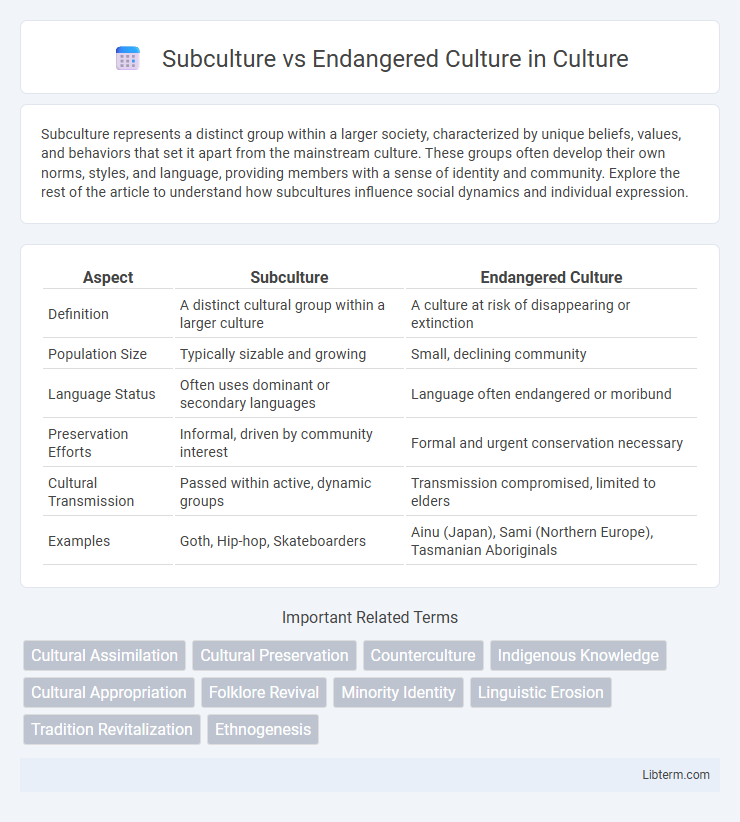Subculture represents a distinct group within a larger society, characterized by unique beliefs, values, and behaviors that set it apart from the mainstream culture. These groups often develop their own norms, styles, and language, providing members with a sense of identity and community. Explore the rest of the article to understand how subcultures influence social dynamics and individual expression.
Table of Comparison
| Aspect | Subculture | Endangered Culture |
|---|---|---|
| Definition | A distinct cultural group within a larger culture | A culture at risk of disappearing or extinction |
| Population Size | Typically sizable and growing | Small, declining community |
| Language Status | Often uses dominant or secondary languages | Language often endangered or moribund |
| Preservation Efforts | Informal, driven by community interest | Formal and urgent conservation necessary |
| Cultural Transmission | Passed within active, dynamic groups | Transmission compromised, limited to elders |
| Examples | Goth, Hip-hop, Skateboarders | Ainu (Japan), Sami (Northern Europe), Tasmanian Aboriginals |
Introduction to Subcultures and Endangered Cultures
Subcultures are distinct social groups within a larger culture, characterized by unique styles, beliefs, and behaviors that differentiate them from the mainstream. Endangered cultures face the threat of extinction due to factors such as globalization, assimilation, and loss of language or traditions. Understanding the dynamics between subcultures and endangered cultures provides insight into cultural diversity and the importance of preservation efforts.
Defining Subculture: Characteristics and Examples
Subculture refers to a distinct group within a larger culture that differentiates itself through unique values, norms, language, and lifestyle, often emerging within youth groups, music scenes, or occupational communities. Characteristics include shared beliefs, symbolic expressions, and practices that promote group identity, such as punk, goth, or hip-hop cultures. Unlike endangered cultures, subcultures thrive on innovation and adaptability, maintaining relevance within dominant societal frameworks.
Understanding Endangered Cultures: Origins and Risks
Endangered cultures originate from unique historical, environmental, and social contexts that have sustained distinct languages, customs, and traditions over centuries. They face risks such as globalization, loss of native languages, environmental degradation, and cultural assimilation, which threaten their survival and transmission to future generations. Preservation efforts focus on documentation, revitalization programs, and empowering indigenous communities to maintain cultural heritage in the face of rapid change.
Key Differences Between Subcultures and Endangered Cultures
Subcultures represent distinct social groups within a larger culture, characterized by unique behaviors, styles, and beliefs that coexist without threatening the dominant culture's survival. Endangered cultures face the risk of extinction due to factors like globalization, loss of language, and diminished traditional practices, which severely impact cultural continuity. The key difference lies in subcultures thriving as alternative identities, while endangered cultures struggle for preservation and survival.
Social Functions of Subcultures
Subcultures serve vital social functions by providing members with a sense of identity, belonging, and community that contrasts with mainstream culture, fostering innovation and cultural diversity. They often challenge dominant norms and values, creating spaces for expression and resistance that promote social cohesion within the group. Unlike endangered cultures, which face risks of extinction due to external pressures and loss of transmission, subcultures actively evolve and adapt, maintaining dynamic roles within contemporary societies.
Factors Leading to Cultural Endangerment
Factors leading to cultural endangerment include globalization, which promotes dominant cultural norms and diminishes local traditions, and loss of language, a critical carrier of cultural identity and knowledge. Economic development often results in habitat destruction and displacement of indigenous populations, weakening the transmission of cultural practices. Political marginalization and lack of institutional support further accelerate cultural assimilation and extinction, distinguishing endangered cultures from subcultures that persist with adaptive resilience.
Preservation vs. Evolution: Contrasting Approaches
Subcultures emphasize evolution by adapting customs and practices to contemporary contexts, fostering identity fluidity and innovation within groups. Endangered cultures prioritize preservation, seeking to maintain traditional knowledge, languages, and rituals to prevent loss of cultural heritage and continuity. The contrast lies in subcultures embracing change and diversity, while endangered cultures focus on safeguarding authenticity against external pressures and assimilation.
Globalization’s Impact on Subcultures and Endangered Cultures
Globalization accelerates cultural homogenization, threatening endangered cultures by diminishing linguistic diversity and traditional practices, while simultaneously fostering vibrant subcultures through digital connectivity and cross-cultural exchanges. Endangered cultures often struggle against dominant global narratives that marginalize their unique identities, risking loss of heritage and historical continuity. In contrast, subcultures harness global platforms to amplify distinct social expressions, creating resilient communities that challenge mainstream cultural paradigms.
Case Studies: Subcultures and Endangered Cultures in Practice
Case studies of subcultures such as the punk movement in the UK illustrate how vibrant alternative communities maintain distinct identities despite mainstream pressures. In contrast, endangered cultures like the Ojibwe in North America face critical threats from language loss and assimilation, prompting urgent preservation efforts. These practical examples highlight the resilience of subcultures versus the vulnerability of endangered cultures in preserving cultural heritage.
Strategies for Protecting Endangered Cultures
Protecting endangered cultures involves strategies such as documenting oral histories, supporting indigenous languages through education programs, and promoting cultural heritage tourism to generate economic incentives. Community-led initiatives emphasizing cultural revitalization empower local populations to reclaim traditions and knowledge. Legal frameworks and international cooperation, including UNESCO's conventions, provide institutional support for preserving vulnerable cultural identities.
Subculture Infographic

 libterm.com
libterm.com